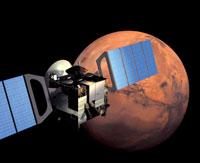Next stop Mars

The passion for knowing Mars is not even yesterday morning and it is not surprising, especially if you consider that it is quite close to Earth and has a special color. But, in addition to color, it has other peculiarities, and from them have spread numerous stories and beliefs. For example, around 1870, astronomer Giovanni Schiapparelli claimed to have seen the canals of Mars through the telescope. This provoked the imagination of several astronomy fans, who considered them as an artificial channel built by the being.
In addition, according to the seasons, the surface colors of the planet change, so it was thought that in the hot seasons vegetation was produced and in the cold disappeared. In science fiction novels the Martians, small and green, and in 1898
H.G. Wells told in the War of the Worlds that technologically advanced Martians conquered the Earth.
Is there water on Mars?
Over time, the steps taken in space exploration have nullified all these convictions. However, Mars remains a target. So far, the U.S.
space agency, NASA, has made the most effort to know Mars, and since its budgets has allocated large amounts of money to Mars related missions. Despite having failed more than once and sometimes for obvious errors, Mars has not lost interest in NASA. When they have had trouble getting money, they have had to mention that on Mars there can be water to break the passion for Mars.

The idea that there is life on Mars is very attractive and, from time to time, they publish articles about the water of Mars, or about the possibility of water. These, together with the discovery of bacteria living in extreme conditions on Earth, reinforce this idea. "If there is water, there may be life, and there are beings capable of living in these situations on Earth, why not on Mars?" That is the idea they drive. Based on this, he will launch the Mars Rovers mission between June and July. The idea is to put two vehicles on the surface of Mars for each to study one side of the planet. With their data they hope to know something more about the geology, climate and water of Mars.
But the current mission is not that of the United States, but that of the Europeans. In any case, the ESA mission coincides with that of NASA: Mars Express aims to unravel the secrets of Mars. With the collected data they want to answer several questions: What forces created the superficial structures of Mars? Why did those forces end? Or does any of them still act? At first was Mars temperate and humid, like the Earth? If so, what made the water and atmosphere disappear? Did he live then? Do these living beings last? Are they found in underground aquifers?
It is clear that ESA did not want to escape from what unites Mars with water. So exciting! However, the data collected in the mission will allow us to know Mars better, and although the last questions remain unanswered, they hope to find the answer of many others.
Mars Express on the way to Mars

To send Mars Express to Mars, ESA has not chosen this era without more; between late May and early June, Mars and Earth will be relatively close. In case this option is lost, they would have to wait twenty-six months to get back to that distance, so these days they would have to try.
The Mars Express ship will leave the Baiconur launch center of Kazakhstan with the help of a Russian rocket Soiuz. As soon as you escape the gravity of the Earth, you will make a six-month excursion at a speed of 10,800 km/h to the orbit of Mars. Once you meet the planet, you will have two tasks: on the one hand, you will have to leave your Beagle 2 vehicle in the place chosen for Mars and, on the other, place it in the orbit of Mars.
Mars Express aims to be in the orbit of the red planet for at least one Martian year, that is, 687 Earth days. During this time, the closest point to Mars will move so that scientific instruments can collect data from the entire surface. These measurements will serve above all to know the Martian atmosphere and to develop a global map of the surface of Mars.
Exploring the skin of Mars

One of the peculiarities of the mission is the Beagle 2, which explores the skin of Mars. It is not the first vehicle to be placed on the surface of Mars, as NASA's Sojourner made a minimum travel of 100 meters. But then it was lost. See if Beagle 2 is more successful!
The tasks of Beagle 2 are: to carry out geological studies, to investigate the chemical composition of the skin and the mineral, to study the weather and the... How not, seek the traces of life! It's not an easy job! In the coming months we will be aware of all this.
Buletina
Bidali zure helbide elektronikoa eta jaso asteroko buletina zure sarrera-ontzian











